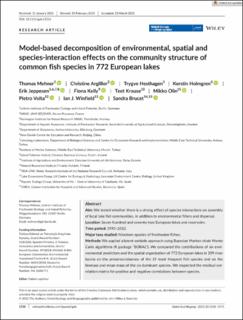| dc.contributor.author | Mehner, Thomas | |
| dc.contributor.author | Argillier, Christine | |
| dc.contributor.author | Hesthagen, Trygve H. | |
| dc.contributor.author | Holmgren, Kerstin | |
| dc.contributor.author | Jeppesen, Erik | |
| dc.contributor.author | Kelly, Fiona | |
| dc.contributor.author | Krause, Teet | |
| dc.contributor.author | Olin, Mikko | |
| dc.contributor.author | Volta, Pietro | |
| dc.contributor.author | Winfield, Ian J. | |
| dc.contributor.author | Brucet, Sandra | |
| dc.date.accessioned | 2022-03-25T07:51:59Z | |
| dc.date.available | 2022-03-25T07:51:59Z | |
| dc.date.created | 2021-07-15T15:44:56Z | |
| dc.date.issued | 2021 | |
| dc.identifier.citation | Global Ecology and Biogeography. 2021, 30 (8), 1558-1571. | en_US |
| dc.identifier.issn | 1466-822X | |
| dc.identifier.uri | https://hdl.handle.net/11250/2987523 | |
| dc.description.abstract | Aim: We tested whether there is a strong effect of species interactions on assembly of local lake fish communities, in addition to environmental filters and dispersal. Location: Seven hundred and seventy-two European lakes and reservoirs. Time period: 1993–2012. Major taxa studied: Nineteen species of freshwater fishes. Methods: We applied a latent variable approach using Bayesian Markov chain Monte Carlo algorithms (R package “BORAL”). We compared the contributions of six environmental predictors and the spatial organization of 772 European lakes in 209 river basins on the presence/absence of the 19 most frequent fish species and on the biomass and mean mass of the six dominant species. We inspected the residual correlation matrix for positive and negative correlations between species esults: Environmental (50%) and spatial (10%) predictors contributed to the presence/absence assembly of lake fish communities, whereas lake size and productivity contributed strongly to the biomass and mean mass structures. We found highly significant negative correlations between predator and prey fish species pairs in the presence/absence, biomass and mean mass datasets. There were more significantly positive than negative correlations between species pairs in all three datasets. In addition, unmeasured abiotic predictors might explain some of the correlations between species. Main conclusions: Strong effects of species interactions on assembly of lake fish communities are very likely. We admit that our approach is of a correlational nature and does not generate mechanistic evidence that interactions strongly shape fish community structures; however, the results fit with present knowledge about the interactions between the most frequent fish species in European lakes and they support the assumption that, in particular, the mean masses of fish species in lakes are modified by species interactions. community assembly, dispersal, environmental filters, latent variables, model-based analysis, predator–prey interactions | en_US |
| dc.language.iso | eng | en_US |
| dc.rights | Navngivelse 4.0 Internasjonal | * |
| dc.rights.uri | http://creativecommons.org/licenses/by/4.0/deed.no | * |
| dc.subject | community assembly | en_US |
| dc.subject | dispersal | en_US |
| dc.subject | environmental filters | en_US |
| dc.subject | latent variables | en_US |
| dc.subject | model-based analysis | en_US |
| dc.subject | predator–prey interactions | en_US |
| dc.title | Model-based decomposition of environmental, spatial and species-interaction effects on the community structure of common fish species in 772 European lakes | en_US |
| dc.type | Peer reviewed | en_US |
| dc.type | Journal article | en_US |
| dc.description.version | publishedVersion | en_US |
| dc.rights.holder | © 2021 The Authors | en_US |
| dc.subject.nsi | VDP::Zoologiske og botaniske fag: 480 | en_US |
| dc.subject.nsi | VDP::Zoology and botany: 480 | en_US |
| dc.source.pagenumber | 1558-1571 | en_US |
| dc.source.volume | 30 | en_US |
| dc.source.journal | Global Ecology and Biogeography | en_US |
| dc.source.issue | 8 | en_US |
| dc.identifier.doi | 10.1111/geb.13314 | |
| dc.identifier.cristin | 1921889 | |
| cristin.ispublished | true | |
| cristin.fulltext | original | |
| cristin.qualitycode | 2 | |

